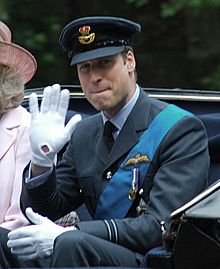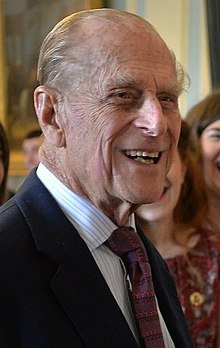A Royal Puzzle: What Is Prince William's Last Name?
Diana, the Princess of Wales, gave birth to her first son on 21 June 1982 at St. Mary's Hospital, London. Together with Prince Charles, she gave her little boy a very big name indeed: William Arthur Philip Louis Mountbatten-Windsor.
Quite a train wreck, that, and the hyphenated last name, Mountbatten-Windsor, often puzzles people.

Why Mountbatten?
Simple answer: William's grandfather, the Queen's husband, is Prince Philip Mountbatten. By a special order in 1960, the Queen decreed that all of her children and grandchildren were to use the name Mountbatten-Windsor.
The change was apparently made to respect her husband's feelings. It would be unfair, after all, for the Queen to ask Prince Philip to see his children and grandchildren bear his wife's last name, Windsor, but not his own last name, Mountbatten.
Mountbatten-Windsor was a compromise.
There's only one problem with the results: both names are phony.
Queen Elizabeth Windsor's family name was originally Saxe-Coburg-Gotha. King George V changed the family's name to Windsor in 1917, because German names were extremely unpopular in Britain during World War I .
Prince Philip's clunky family name sounded horribly German too. Philip decided to erase it and replace it with "Mountbatten" back in 1947, when Philip and Elizabeth were preparing for their own royal wedding.

What was the clunky family name of Prince William's grandfather, Philip?
Born on 10 June 1921 as Prince Philip of Greece and Denmark, Philip was a descendant of the ancient Danish House of Oldenburg. His father, Prince Andrew of Greece and Denmark, married Alice of Battenberg, a granddaughter of Queen Victoria.
On his father's side, then, Philip had no real birthname. Like many members of royalty, he used only a first name. His family was styled as the "House of Greece and Denmark" but that was because "Greece and Denmark" is much easier to remember than the family's real name: Schleswig-Holstein-Sonderburg-Glucksburg.
If necessary, royal historians can explain how the House of Schleswig-Holstein-Sonderburg-Glucksburg came to be elected as Kings of Greece during the Greek National Assembly of 1863, but it would make your eyes roll back up into your skull.
Saucy Brits simply refer to Prince Philip as "Phil the Greek," and leave it at that. His mother's side descends from Queen Victoria, and that's what counts.
Where did Prince Philip get the name Mountbatten?
In 1939, Prince Philip's maternal uncle, Earl Louis Mountbatten, urged him to attend Dartmouth Naval College and to join the Royal Navy. While attending the college, Philip acted as a formal escort to Princess Elizabeth, who fell in love with him. They exchanged letters throughout the war, and in summer 1946 Philip asked King George VI for his daughter's hand in marriage.
The King consented, but there were some difficult obstacles. Philip had to renounce his membership in the Greek Orthodox Church, join the Church of England, renounce all allegiance to the Greek crown, swear allegiance to the crown of England, and then become a naturalized citizen of England. That meant he had to renounce all former names and titles.
Philip agreed to all of this. The last one was easy. Who wouldn't renounce a name like Schleswig-Holstein-Sonderburg-Glucksburg?
In March 1947, faced with a blank space on his application to become a citizen of the United Kingdom, Prince Philip decided to adopt the surname Mountbatten -- his maternal uncle's name.
This was all done as part of the legal preparation for Philip's marriage to Princess Elizabeth Windsor, the heir presumptive to King George VI. Philip loved Elizabeth, and was glad to comply.
Unfortunately, while vetting the Prince and his background, the royal family discovered some additional problems: Nazi skeletons in Prince Philip's family closet.
Why didn't Prince Philip become King of England?
In 1930, Prince Philip's four older sisters had married German noblemen.
As author Kitty Kelly revealed in her 1997 book The Royals, "One was an S.S. Colonel on Himmler's personal staff, and the others were Princes who supported the Nazis during World War II. One sister, Sophie, named her eldest son Karl Adolf in honor of Adolf Hitler . . . ."
Prince Philip himself had been named after an uncle, Prince Philip of Hesse, who was "Hitler's personal messenger and functioned so effectively for the Fuhrer that he was awarded an honorary generalship in the Storm Troopers."
Until his death in 1943, "another of Philip's uncles -- Prince Christopher of Hesse -- was the head of the secret phone-tapping service in Goring's research office; this unit eventually became the Gestapo, the Nazi's secret state police."
In 1947, the year of the royal wedding, the British public remembered the fire-bombing of London very vividly. The royal family's advisors felt that any man with a family history like Philip's would be stubbornly rejected by the British people. They would never accept him as a King of England.
Philip was therefore told that if he wished to marry Princess Elizabeth, he would have to forsake all rights to the crown of England. Elizabeth would rule, and Philip must quietly accept his role as that of a Prince Consort only.
Philip was also strongly advised to change his name.
On the morning of 20 November 1947, the dashing young Lt. Philip Mountbatten married Princess Elizabeth Windsor at Westminster Abbey. It was a grand ceremony recorded and broadcast worldwide by BBC radio. The world was little aware of just how much Philip had agreed to sacrifice in order to marry the woman he loved.
King George VI died on 6 February 1952, and Elizabeth was crowned as the new Queen of England on 2 June 1952. Prince Philip was given the title "Duke of Edinburgh" on his wedding day, and when Elizabeth became Queen she formally granted him "place, pre-eminence and precedence" on all occasions and in all meetings, but he was never formally crowned as England's King. That was part of the humiliating wedding contract to which Philip had agreed.
Why not change the name to House of Mountbatten?
With Elizabeth's accession to the throne, the question now arose whether the new royal house should be called the House of Windsor or the House of Mountbatten. The royal family had changed their name as recently as 1917, when they decided to lose Saxe-Coburg-Gotha in favor of Windsor. Why not change the name again?
Philip's uncle Louis lobbied enthusiastically for changing the royal family's name to Mountbatten. But Elizabeth's grandmother, Queen Mary, pressed Winston Churchill to intercede. Churchill strongly advised the young Queen Elizabeth to issue a royal proclamation that the royal house would remain known as the House of Windsor.
Cornered between her grandmother, Britain's most famous prime minister, and her husband, Elizabeth deferred to Queen Mary and asked her husband to please understand.
Philip didn't understand. He privately complained, "I am nothing but a bloody amoeba! I am the only man in the country not allowed to give his own name to his own children!"
Queen Elizabeth felt her husband's pain. He made sure of that.
Settling for an Awkward Hyphenate
In 1960, after Queen Mary had died and Winston Churchill had resigned, the Queen decided to change the rules enough to make Philip happy. She quietly proclaimed in Council that the surname of male-line descendants of the Duke of Edinburgh and the Queen who are not styled as Royal Highness, or titled as Prince or Princess, was to be Mountbatten-Windsor.
That means William can use Windsor, and his W.O.W ("William of Windsor") monograms are strictly accurate. Prince William, as an HRH, is not required to use the hyphenate form.
In practice, however all of the children and grandchildren of Queen Elizabeth and Prince Philip use the style Mountbatten-Windsor. Prince William often does so out of respect for the feelings of his grandfather, Prince Philip.
So what is William's last name, really?
To answer the question accurately, one must say:
"Technically it is Windsor, in practice it is Mountbatten-Windsor, in terms of patronymics it ought to be Mountbatten, and if one looks at the royal house of his paternal grandfather's lineage, it ought to be Oldenburg or, more precisely, Schleswig-Holstein-Sonderburg-Glucksburg. "
When it comes to printing new business cards, then, Kate Middleton is in a real jam. If she's honest, she'll tell the printer that her new name is Catherine Saxe-Coburg-Gotha-Schleswig-Holstein-Sonderburg-Glucksburg.
For now, Mrs. W.O.W. will do.
Sources
- Kelley, Kitty. The Royals. New York, Warner Books, 1997. pp. 2, 46, 55.
- "The Royal Family Name." Official Website of the British Monarchy.
- "William Arthur Louis Philip Windsor, Prince of the United Kingdom" Peerage.com